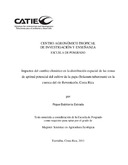| dc.contributor.advisor | Velasquez, Sergio | es_ES |
| dc.contributor.author | Babilonia Estrada, Rique | |
| dc.date.accessioned | 2014-10-20T04:23:44Z | |
| dc.date.available | 2014-10-20T04:23:44Z | |
| dc.date.issued | 2011 | es_ES |
| dc.identifier | 376676 | es_ES |
| dc.identifier.uri | https://repositorio.catie.ac.cr/handle/11554/4629 | |
| dc.description | Tesis (Maestría) - CATIE, Turrialba (Costa Rica), 2011 | es_ES |
| dc.description.abstract | Se evaluó el impacto del cambio climático en el desplazamiento de las zonas de aptitud del cultivo de la papa a través de la metodologia de evaluacion de tierras de la FAO apoyado por el software ALES, a partir de escenarios climáticos generados con dos modelos de circulación general. Se determinaron dos clases de aptitud física A3 (Marginalmente Apto) y A4 (No Apto) y aptitud económica por MB, rendimiento y Producción total en la zona productiva. Se encontraron MB actuales de 1962 millones de colones y rendimientos no mayores a 23.98 tn/ha y una produccion total de 754 mil tn/ha. En ambos escenarios, las zonas de aptitud fisica y economica sufrieron cambios en la reducción de sus áreas hacia altitudes mayores, se encontró un riesgo medio a alto de T. solanivora, P. infestans y degradación del suelo. La clase de aptitud mas afectada es A3 para ambos modelos. El rendimiento es variable con el modelo HadCM3 y se mantiene igual con CSIRO respecto al escenario actual. La clase A3 presenta limitaciones por temperatura máxima, minima, precipitación, pendiente y altitud. El modelaje de las zonas de aptitud ante escenarios de cambio climático genera información sobre el grado de sensibilidad y permite diseñar estrategias de mitigación y adaptación al cambio climático. | es_ES |
| dc.description.abstract | We evaluated the impact of climate change on the displacement of areas suitable for potato cultivation through the land evaluation methodology of the FAO-supported software ALES, based on climate scenarios generated by two general circulation models. Two suitability classes were determined: A3 (marginally suitable) and A4 (not suitable) and the economic viability by gross margin (GM), yield and total production in the productive zone. Actual GM of 1962 million colones and yield no greater than 23.98 t/ha and total production of 754 million t/ha. In both scenarios, the physically and economically suitable zones demonstrated changes in the reduction of their areas toward higher altitude, a medimn to high risk of pest (T solanivora, P. infestans) infestation and soil degradation was found. The suitability class most affected was A3 for both models. The yield is variable with the model HadCM3 and remains the same with CSIRO when compared to the actual scenario. Class A3 presents limitations for maximum and minimum temperature and precipitation, in addition to gradient and altitude. Modeling of suitability zones based on climate change generates information on the grades of sensitivity and permits the design of strategies for the mitigation and adaptation to climate change. | en_EN |
| dc.language.iso | es | es_ES |
| dc.publisher | CATIE, Turrialba (Costa Rica) | es_ES |
| dc.subject | COSTA RICA | |
| dc.subject | SOLANUM TUBEROSUM | |
| dc.subject | VOCACION DE LA TIERRA | |
| dc.subject | CULTIVO | |
| dc.subject | CAMBIO CLIMATICO | |
| dc.subject | GASES DE EFECTO INVERNADERO | |
| dc.subject | IMPACTO AMBIENTAL | |
| dc.subject | ADAPTACION | |
| dc.subject | MODELOS DE SIMULACION | |
| dc.subject | CUENCAS HIDROGRAFICAS | |
| dc.title | Impactos del cambio climático en la distribución espacial de las zonas de aptitud potencial del cultivo de la papa (Solanum tuberosum) en la Cuenca del Río Reventazón, Costa Rica | es_ES |
| dc.title.alternative | Climate change impacts on the spatial distribution of the zones with potential for the cultivation of potato (Solanum tuberosum) in the watershed of the Reventazón river in Costa Rica | es_ES |
| dc.type | Tesis de maestría | es_ES |
| dcterms.rights | Acceso abierto | es |
| dc.identifier.publication | Turrialba (Costa Rica) | es_ES |


